Affray II (MSO-511)
1958–1993
The second U.S. Navy ship named for the general word classification.
II
(MSO-511: displacement 750; length 173'; beam 36'; draft 14'; speed 14 knots; complement 78; armament 1 40 millimeter, 2 .50-cal. machine guns; class Acme)
The second Affray (MSO-511) was laid down on 24 August 1955 at Boothbay Harbor, Maine, by Frank L. Sample Jr., Inc.; launched on 18 December 1956; sponsored by Mrs. Harriet F. Glick, wife of Rear Adm. John A. Glick (Ret.); and commissioned on 8 December 1958, Lt. Cmdr. Charles I. Williams in command.
After fitting out, Affray completed a restricted availability at Boston [Mass.] Naval Shipyard (31 December 1958–14 January 1959). Affray joined the Atlantic Fleet Mine Force with Mine Division (MineDiv) 45 of Mine Squadron (MineRon) 4, when she set course for her new homeport of Charleston, S.C., on 31 January. The minesweeper then devoted the first six months of 1959 to shakedown and type training. Affray completed her shakedown (February–March 1959), and on 30 March joined seven other ships of MineRon 4 as they made a training cruise to Bermuda. She took part in Armed Forces Day on 17 May at Gloucester, Mass., and then (29 June 1959–25 January 1960) entered Charleston Naval Shipyard for her post-shakedown overhaul, the addition of modernization alterations complicating her repairs. Affray completed her final acceptance trials on 1 March 1960, followed by refresher training (RefTra) and minesweeping refresher training with the Fleet Training Group at Charleston.
The ship completed a three-week tender availability and accomplished her first deployment during a voyage with the seven other ships of a mine countermeasures group to the Caribbean (23 May–July 1960), also visiting St. Thomas in the Virgin Islands, Montego Bay, Jamaica, and San Juan, P.R., where Lt. Cmdr. M. Gaydos relieved Williams as the commanding officer on 7 July 1960. The vessel took part in multi-threat exercise MidLantCru 2-60 off the South Carolina coast. Affray then (28 October 1960–19 May 1961) deployed with MineDiv 45 to the Sixth Fleet in the Mediterranean. The ship spent 17 days crossing the Atlantic, two days at Rota, Spain, and then passed through the Strait of Gibraltar into the Mediterranean to operate with Task Force (TF) 61, the Sixth Fleet’s amphibious task force. Her duties consisted mainly of exercises -- joining nearly 30 ships and submarines in one such amphibious exercise -- and goodwill visits to various ports including France, Greece, Spain, Italy, and Monaco, and at times she operated with British, French, and Italian ships. She celebrated Christmas at Livorno, Italy.
The ship also acted as a tow vessel for the ships and aircraft of TF 60, the fleet’s fast attack force, and her historian observed that many of her crewmen candidly considered this task “the most trying and exasperating duty which AFFRAY was called upon to render.” Vice Adm. George W. Anderson, Commander Sixth Fleet, however, later sent the ship and her crew a congratulatory message acknowledging that work:
“General performance Affray during recent duty tow vessel for surface gunnery exercises was far in excess with what could reasonably have been expected despite adverse weather, parted tow lines, and frequent schedule changes. This little vessel carried on the fine can do spirit. Firing ships consistently reported outstanding services rendered by Affray. This performance indication of high state of training and high degree professionally.”
Affray laid and then swept exercise mines during LantMidCru 2-62, and completed an overhaul at Charleston Naval Shipyard (September 1961–January 1962). Lt. (j.g.) R.D. Van Landingham relieved Gaydos in September, and Lt. Cmdr. J.H. Thorp relieved Van Landingham on 21 November. Upon concluding her yard work, the ship carried out RefTra, and later engaged in special minesweeping problems at Norfolk, Va. While steaming in company with Fidelity (MSO-443) off Cape Hatteras, N.C., en route to Norfolk in February 1962, heavy weather severely damaged the ship’s decks, causing her to return to Charleston for repairs.
Affray deployed again with the division to the Caribbean (12 April–31 July 1962). On 2 and 3 October, the ship operated off Cape Canaveral, Fla., with attack aircraft carrier Lake Champlain (CVA-39) and other ships and aircraft as part of the recovery force for Cmdr. Walter M. Schirra, who piloted space capsule Sigma 7 during the launch of Mercury-Atlas-8 from Cape Canaveral — Sigma 7 splashed down in the Pacific.
The ship passed a Board of Inspection and Survey early in the New Year in 1963, a crucial milestone in determining her readiness for war. She passed additional such inspections in subsequent years. In February Affray deployed with MineDiv 45 to the Caribbean. Lt. Cmdr. Allen Smith III, relieved Thorp on 1 July, and then the ship spent July 4th at Jacksonville, Fla. She completed an overhaul at Savannah Machine and Foundry Co., at Savannah, Ga. (21 August–28 October), followed by RefTra (15 November–3 December 1963). Affray deployed to the Mediterranean (10 January–June 1964), and that October underwent two weeks of interim docking at Detyen’s Shipyards, Inc., Wando, S.C. In December, she steamed to the coast off Cape Canaveral to support the launch of unmanned space capsule Gemini II, but a malfunction cancelled the launch, originally scheduled for 9 December 1964.
The warship next (February–June 1965) sailed to the Caribbean, during which she patrolled the Windward Passage and participated in exercise Quick Kick VII. Lt. Cmdr. A.P. Porcaro relieved Smith on 16 July. The minesweeper accomplished an overhaul at Jacksonville Shipyard (October 1965–January 1966). After emerging from the shipyard, she operated primarily off Charleston, except for a brief trip to celebrate Independence Day at Brunswick, Ga., and a voyage to Nassau in the Bahamas, where she worked with the David Taylor Model Basin’s self-propelled water barge Monab (YW-87), towing acoustic devices at Exuma Sound (17–27 August). At times during the year, manning issues reduced her crew to less than 50% of her authorized complement, hindering her operational readiness.
On 21 September 1965, Affray set sail for RefTra at Guantánamo Bay, Cuba, but Hurricane Inez intervened. Meteorologists believed that the tempest would pass within about 50 miles of Cuban waters, and Affray and six other small ships consequently attempted to ride out the storm by anchoring in the bay. The hurricane changed course, however, and churned through the area. Winds approaching 100 knots lashed the ships at anchor, and waves reaching 12 feet smashed into them. The ships dragged their anchors in zero visibility, and three of their radars’ failed. The division’s leader broke his flag in Affray, situating himself in her Combat Information Center (CIC) while the CIC watch team plotted the ships and made timely course recommendations to prevent them from dragging onto shoals. Radarman 2nd Class Francis J. Klett subsequently received a Navy Commendation Medal for his achievements during the storm, but Lt. Cmdr. Porcaro afterward succinctly summarized that “a small ship at anchorage and a hurricane are mortal and avoidable enemies.” Affray completed repairs and then continued her RefTra, refueling from the starboard side of mine countermeasures support ship Ozark (MCS-2) while another minesweeper refueled from Ozark’s port side on 19 October. Affray returned to Charleston. During 1966 the ship also observed Soviet intelligence trawlers spying on U.S. ships and submarines entering and leaving Charleston.
Early in the New Year, Affray swept for exercise mines while steaming to Mayport, Fla. (16–26 January 1967). She carried out maintenance and had her bottom painted while in non-self-propelled medium auxiliary repair dry dock Alamogordo (ARDM-2) during most of March. The ship then returned to the Caribbean (14 April–10 May), where she took part in Operation Clovehitch III off the southern coast of Puerto Rico and a week’s type training and an operational readiness inspection at St. Thomas. Affray carried out propeller repairs while drydocked at Detyen’s (28–30 June).
The ship made for Caribbean waters again (7 August–4 December) for exercise Carib 2-67. She operated out of Guantánamo Bay in early August, visited Kingston, Jamaica (17–19 August), Hurricane Beulah cut a wide swath of destruction across the Caribbean the following month, and the ship stood out of port to evade the hurricane (10–14 September). Affray patrolled the Windward Passage, operated off Guantánamo Bay, and on October took part in Project Flood when she performed hydrographic survey operations and took bottom sediment samples from both Sivler and Mouchoir Banks north of the island of Hispaniola. She then (10–20 October) visited Roosevelt Roads, P.R., where Lt. Eugene M. Kennedy relieved Porcaro on 17 October. The ship then (21–25 October) swept exercise mines for an amphibious task force during an exercise south of Vieques Island, P.R., transporting a marine reconnaissance platoon to their designated landing area and serving as a plane guard for amphibious assault ship Guadalcanal (LPH-7). Affray returned to San Juan (26–30 October), resumed her operation off Guantánamo Bay (3–30 November), and then came about for home.
In the first part of January 1968, the ship steamed from Charleston to Key West, Fla., where she underwent a shock test on 11 January. Following the test she entered Detyen’s for an overhaul (22 January–22 August), which included replacing the AN/UQS-1 sonar with AN/SQQ-14 variable depth sonar, replacing her 40 millimeter mount on the forecastle with the new sonar’s winch, and installing enhanced communications and navigation equipment. On 28 October Affray conducted an expanded square search using her sonar for trawler Eugenia, which disappeared off the coast of Georgetown, S.C., but failed to locate the missing fishermen or their boat. Affray next (19 November–5 December) accomplished RefTra at Charleston, her historian noting that the crew “had learned the rewards of working together.” During the winter sailors and civilian workers overhauled Nos 3 and 4 main engines.
Affray deployed with MineDiv 45, in company with salvage ship Opportune (ARS-41), gasoline tanker Nespelen (AOG-55), and Greek motor minesweepers Argo (M.213) and Avra (M.214), to the Mediterranean (8 May–30 October 1969). She initially visited Rota (26–29 May) and Cartagena, Spain (31 May), and Naples, Italy (6–9 June). The ship then took part in a fleet service mine test through 18 June, and operated with the Sixth Fleet (10–28 July), breaking her cycle of rigorous steaming by standing in to Valletta, Malta (17–21 July). The minesweeper and her crewmen continued their relationship with the Spaniards, visiting Palma Mallorca (28 July–6 August) and Malaga (9–11 August), before coming about and crossing the Mediterranean steering easterly courses. Affray reached Augusta, Sicily, on 25 August, and visited Piraeus, Greece (1–13 September). She then (16–25 September) took part in MedSweepEx 69, a NATO mine warfare exercise. The ship then turned her bow westward for home, visiting Rota (7–11 October), where Lt. Cmdr. Richard W. Russell relieved Kennedy on 10 October, the Azores four days later, and Bermuda on 25 October before returning to Charleston.
Early in the New Year the ship operated off Fort Lauderdale (9–19 February 1970), and then (3–10 April) anchored in Charleston’s lower harbor and took part in the city’s Tri-Centennial celebration. Affray steamed in company with Exploit (MSO-440) to Panama City, where she worked with the Mine Defense Laboratory (18 May–24 June). Affray and Exploit twice located a downed airplane, on 5 and 18 June, respectively, the second time necessitated because the markers on the wreck broke loose in rough seas. Affray carried out special minehunting operations in the submarine transit lanes off the South Carolina coast (18–22 August), and completed work at Detyen’s (16 September–9 December), where Lt. Cmdr. John A. Narciso relieved Russell on 19 November.
The ship got underway for RefTra following her yard work but problems in Nos 3 and 4 main engines compelled her to return to Charleston (21–22 January 1971). Completing her repairs and then RefTra, Affray joined the other three ships of the division, Alacrity (MSO-520), Exploit, and Observer (MSO-461), for minesweeping refresher training off Jacksonville (29 March–2 April). On 1 April, MineDiv 44 was redesignated MineDiv 24. The ship meanwhile visited Mayport (3–4 April) and Port Everglades (10–11 April). Affray and Observer participated in special operations on the Autec Range, Andros Island, Bahamas (17–23 May). Affray took part in several exercises during the remainder of the year, including type training with Alacrity and Observer (7–10 June) and working with helicopters and the ships of the division (14–19 June), both exercises off Charleston. She evaluated the sea-fix buoy system in Charleston with Observer (12–16 July), trained with Observer off Charleston (26–30 July), and then (9–13 August) tested astern refueling both underway and at anchor with Chewaucan (AOG-50). The warship overhauled her sonar hoist and carried out repairs at Detyen’s (13–21 September), and conducted special sonar operations with fleet ballistic missile submarine Theodore Roosevelt (SSBN-600) off Charleston (7–10 October). Affray trained with Dominant (MSO-431) in the Gulf of Mexico over Halloween, and provided testing services for an experimental airborne magnetic sweep tail for the Naval Ships Research and Development Laboratory at Panama City (2–18 November 1971). The ship rounded out the year by replacing her No. 1 main engine.
Affray turned her bow northward for New England waters early in the New Year (10 January–1 February 1972), passing through the Cape Cod Canal and mooring at Boston Naval Shipyard (14–19 January). The ship battled the cold northern weather while recovering exercise mines close to shore, recovered helicopter sweep gear, controlled helos, dropped buoys, and refueled astern while off Sheepscott Bay, Maine, during Snowy Beach (20–25 January). She stopped briefly (26–29 January) in Boston on her return voyage. While taking part in a helicopter mine hunting exercise off Charleston on 13 March, the ship controlled helicopters, carried out a light line transfer, and streamed gear. Affray trained similarly during Exotic Dancer IV off Moorehead City (14–25 May) and during another exercise early the next month (5–9 June). MineRon 21 was disestablished on 1 July 1972, and Affray shifted to MineRon 24, Cmdr. Daniel G. Powell in command. The warship often operated in company with the other vessels of the squadron, which comprised ocean minesweepers Adroit (MSO-509), Alacrity, Assurance, Fearless (MSO-442), and Fidelity. On the day after Independence Day, workers inspected her hull while in (non self-propelled) medium auxiliary repair dry dock Alamogordo (ARDM-2). She continued to train and worked with Alacrity, Assurance, and Helicopter Mine Countermeasures Squadron (HM) 12 in MinEX 5-72 (14–26 August 1972). The ship trained and performed upkeep through the end of the year.
During the first watch on New Year’s Eve 1972, a Douglas DC-7CF registered in the United States as N500AE, with three crewmembers and two passengers including famed baseball star Roberto Clemente [Roberto E.C. Walker], crashed into the Atlantic off Isla Verde, P.R., immediately after takeoff from Isla Verde International Airport, killing all five people on board. Clemente was making the flight to nobly deliver humanitarian relief supplies to victims of an earthquake that had devastated Managua, Nicaragua, on 23 December, two days before Christmas. The Navy called Affray to assist in the search for possible survivors or wreckage, and although Clemente’s body was never found, the ship helped locate part of the plane’s fuselage and its tail. Affray then made for Guantánamo Bay for two weeks of RefTra, followed by a visit to St. Thomas. Affray next (26 March–7 April 1973) took part in Exotic Dancer VII off Onslow Beach, operating with Adroit, Dash (MSO-428), Detector (MSO-429), Direct (MSO-430), and Fidelity as part of Task Unit 124.3.1, the minesweepers assembled for the exercise.
The character of Affray's Navy career changed significantly midway through 1973. On 1 July, she received word of her reassignment to naval reserve training duty and of a change of home ports from Charleston to her new home port of Portland, Maine, shifting to MineRon 12 and MineDiv 121. Affray departed Charleston in company with Adroit on 24 September, reaching Newport four days later, where she detached from Adroit and proceeded independently, arriving at Portland on 1 October. The minesweeper spent the remainder of her career training naval reservists, the first of whom arrived during that initial weekend. While operating in New England waters the ship at times tested and evaluation a NATO mine neutralization system, a new mechanical sweep-wire system, and participated in major exercises emphasizing minesweeping and amphibious warfare, often off Newport and Fisher’s Island.
The following year, the ship took part in the Windjammer Days Festival at Boothbay Harbor (9–12 July 1974). Lt. George C. Harkness relieved Lt. Cmdr. Richard L. Lyons on 14 July. Affray attended the Maine Seafood Festival at Rockland (1–5 August), participated with HM-12 in LantMinEx 2-75 off the Virginia capes (9–12 August), and completed an overhaul at Coastal Drydocks, Inc., Brooklyn, N.Y. (23 October 1974–23 February 1975). The minesweeper took part in fleet exercise Solid Shield 75 (25 May–3 June), and then joined Impervious (MSO-449) as the two ships gave their crewmen a well-deserved break by visiting Port Canaveral (7–9 June). Shortly thereafter, Affray rendezvoused with Carolina Pride, a vessel from the South Carolina Wildlife and Marine Resources Department, and spent several hours using her sonar to locate a sunken wreck, over which the department placed a fishing buoy. The ship returned to the Windjammer Days Festival (4–11 July 1975). On 8 October the mine warfare ship sailed to Boston, where she rendezvoused with destroyer Meredith (DD-890), and they performed various dual ship exercises, returning to Little Creek for additional training on 18 October 1975.
Affray hosted Okanagan (S.74) when the Canadian submarine visited Portland (1–9 January 1976). The ship completed repairs to her hull and main deck while in dry dock at Munro Drydock, Inc., at Boston (21 March–12 May). The minesweeper took part in type exercises and general naval warfare skills during Solid Shield 76 (13–21 May). Affray accomplished maintenance alongside destroyer tender Grand Canyon (AD-28) at Mayport (3–14 July), following which, she renewed her ties with the Windjammer Days Festival (7–9 August). Okanagan graciously returned the ship’s earlier hospitality when she hosted Affray during the minesweeper’s visit to Halifax, Nova Scotia (15–22 September). On 20 October, the ship took in all lines and steamed to Bayonne, N.J., where she accomplished additional upkeep alongside Grand Canyon until 14 November 1976.
On 2 February 1977, Affray buried PO2 Carlos M. Apipez at sea with full honors. Lt. Cmdr. Jeffrey E. Callahan relieved Harkness on 6 February. Affray embarked her reservists on 16 April, and the following day sailed in company with Dash and Inflict (MSO-456) for training. Rendezvousing with Detector, the four ships carried out various surface tracking, communication, general quarters, damage and casualty control drills, as well as moored and combination minesweeping exercises, coming about for a brief visit to Rockland three days later. Affray then revisited Halifax (20–29 April), where Canadian destroyer Assiniboine (DDH.234) hosted her, though foul weather compelled the minesweeper to extend her stay. Affray, Detector, and Inflict steamed from Halifax and conducted a formation moored minesweeping exercise, following which, the division made for Portland to avoid an approaching gale, Affray disembarking her reservists there on 30 April. The ship completed an overhaul at Munro Drydock (13 June–22 September), carrying out some of the work on a marine railway (23 June–12 July). Affray alternated training reservists and upkeep through November, and more than 1,300 people toured the warship when she visited the Naval Academy (21–24 October). The ship then (13–14 December 1977) turned her bow northward for Casco Bay, Maine, where, despite heavy snow and thick sea smoke, she completed a mine hunting exercise and full power trial.
Affray sailed from Portland for maintenance at Charleston on 30 January 1978, but en route a small fire broke out and the ship pulled into Newport for a brief stop to assess the damage. She resumed her voyage, and replaced two engines while at Charleston (1 February–15 March). Following RefTra, the ship returned to Portland, where she intermittingly accomplished maintenance and trained reservists into the spring. The minesweeper took part in Solid Shield ‘78 off Morehead City, embarking her reservists at Charleston and returning them ashore at Little Creek (3–23 May). Following the exercise, Affray headed north for the Windjammer Festival at Boothbay (11–14 July). Lt. Cmdr. Sheldon C. Arey relieved Callahan on 23 July. The ship completed repairs at Newport (24 July–10 August), and then (10–13 August) participated in the Lobster Festival at Winter Harbor, Maine. Affray operated with patrol gunboat Tacoma (PG-92) during the late summer (18–21 September). On 30 September, with very short notice, Affray received orders to conduct a search “for a piece of unidentified equipment lost from a submarine.” The ship searched until 15 October, but then cancelled her part in the search and came about for Newport. She wrapped-up the year by completing an interim drydocking there (17 October–17 December 1978).
The ship then shifted southward to Charleston for maintenance, taking part with her embarked reservists in her first major exercise of the New Year during Solid Shield ’79 (4–22 May 1979). Capt. C. R. Christensen, Commander MineRon 12, broke his flag in the ship when she led the division down the Cooper River during the main portion of the exercise (9–18 May). A mobile training team embarked and assisted the crew to prepare for a mine readiness certification inspection (MRCI), the ship leaving early in the mornings and returning shortly before sunset to train in different minesweeping exercises and rigging for varied sweeps (28–30 June, and 1–3 and 5–6 July). Affray embarked reservists and set out for weekend training on 14 July, but the ship’s fuel oil tanks became contaminated and she limped back into port later that afternoon. After flushing and cleaning tanks, the ship stood down the channel for local operations on 30 July, but experienced problems with the pitch system that compelled her to return for repairs. Following (apparently) successful testing of the system, Affray got underway on 9 August for the MRCI at Charleston, but the system again suffered problems and she put into Little Creek for urgent repairs two days later. The minesweeper continued to Charleston but the ongoing operability issues drove the Navy to cancel the MRCI. A mobile training team nonetheless helped her crewmen practice mine hunting techniques off Charleston, before the ship returned home on 27 August. She accomplished an overhaul at South Portland Shipyard and Marine Railway Co. (18 September 1979–17 April 1980).
On 2 May 1980, Affray sailed for Solid Shield ’80, but a stern tube packing casualty on 8 May precluded further involvement and the ship completed repairs at Detyen’s until 12 June. Following RefTra, the minesweeper returned to Portland. She transited southward and carried out stray field tests off Charleston (10 July–5 September), and on 14 September Lt. Cmdr. Frank H. Tryon Jr., relieved Arey as the commanding officer. On 6 October, Affray headed back to Charleston for an MRCI. The vessel alternated working at the stray fields pier and preparing for the inspectors while underway, but repeated material casualties to the minesweeping gear and engineering equipment hindered the workup schedule. One of the starboard main propulsion engines failed while the ship worked up for the MRCI on 30 November. The ship completed some repairs in Charleston, but the MRCI team decided to continue the inspection with the damaged engine, yet the ship’s main engine failed on the starboard shaft during the inspection while off Charleston and she failed the MRCI (12–14 December 1980). With both starboard main propulsion engines out of commission, Affray moored at Pier Uniform at Charleston to accomplish a two engine change out.
Following the yard work, Affray found herself in familiar waters while taking part in Solid Shield ’81 (29 April–29 June 1981). Explosive Ordnance Disposal (EOD) divers from Mobile Unit 2, based at Fort Story, Va., helped the ship recover deep water exercise mines, and she then completed a month of upkeep at Little Creek before returning to Portland. Lt. Cmdr. Timothy M. Ahern relieved Tryon on 5 September. The ship completed an interim drydocking at Munro (15 September–3 December). On 1 October, after being homeported for nearly eight years at Portland, Affray was reassigned to Naval Education and Training Center, Newport, R.I., mooring to Pier 2 on 3 December 1981.
Affray began 1982 completing post overhaul upkeep and RefTra (2–22 March), and then (16 April–12 May) took part in Ocean Venture ’82 off the coasts of Florida and Georgia, making only a brief stop for replenishment at Mayport on 3 May. Affray departed Newport on 22 May for a port visit to Nassau. She stayed in the scenic islands for two days, then visited Port Everglades (30 May–2 June). The ship served as a test platform for a Chief of Naval Operations project to evaluate the French-built PAP-104 Mine Neutralization System while working out of Panama City. Affray arrived in that port on 5 June, and spent the next 12 days installing two competing winch designs in addition to the system itself. Naval Coastal Systems Center technicians trained the ships company to operate the PAP-104, and the minesweeper carried out daily operations to evaluate it (18 June–2 July). The ship spent Independence Day at Pensacola, replenished at Key West and Little Creek, and returned to Newport on 15 July. Affray returned briefly to the warship’s former homeport of Portland when she supported an EOD detachment from Naval Air Station Brunswick, Maine, during their MRCI (27 August–4 October). The ship replaced Exploit and evaluated the Canadian DART Mine Identification System during Canus-Marcot ’82 in Canadian and New England waters (20 October–12 November 1982).
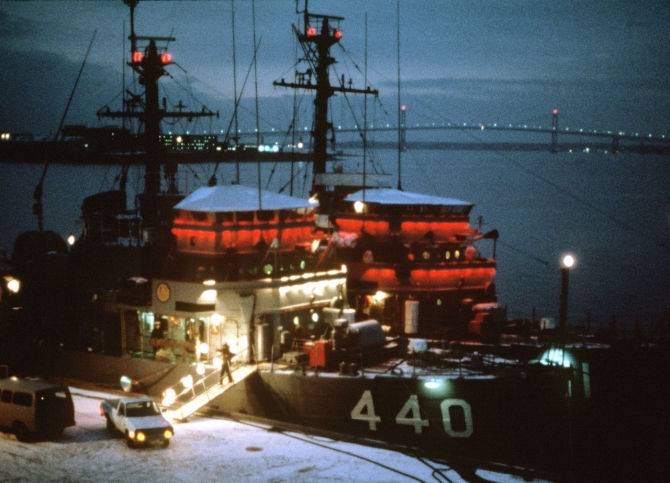
The minesweeper ran daily degaussing runs at the range in Charleston’s lower harbor early in the New Year (13 January–22 February 1983), and then (7 March–2 July) completed an overhaul at Newport Shipyard. Following the yard work, she onloaded ammunition at Naval Weapons Station Earle, N.J. (7–8 July), carried out upkeep at Little Creek, and then (22–30 July) visited the Washington Navy Yard before returning to Newport. Affray completed repairs to the hub on her starboard shaft while in dry dock at Newport (8–20 August), followed by the grueling regimen of RefTra at Little Creek (25 August–11 September). Cmdr. John J. Gallagher relieved Ahern on 24 September. The ship visited Waterside (12–15 October), ran the degaussing range at Lambert’s Point (17–21 October), and completed an MRCI at Charleston (1–3 December), before returning to Newport on 11 December 1983.
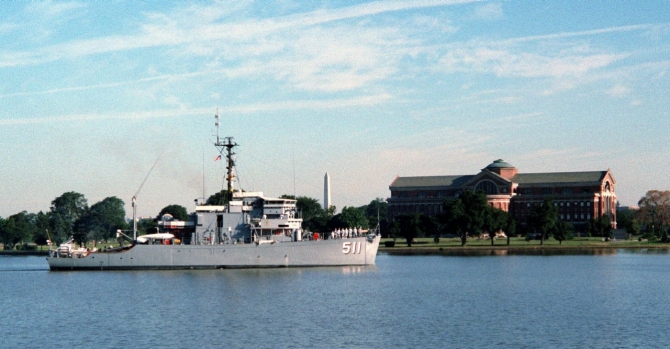
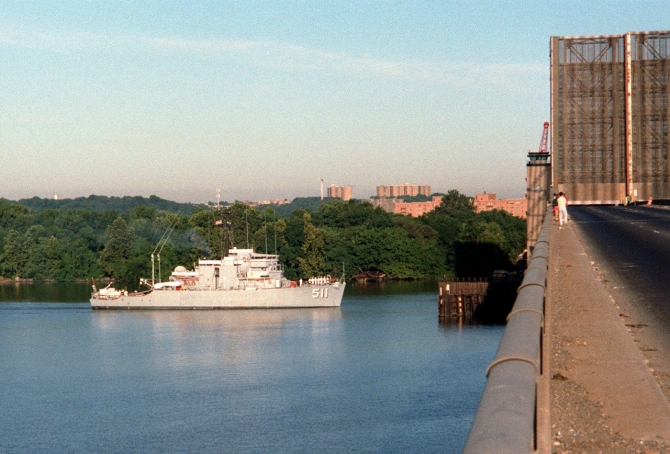
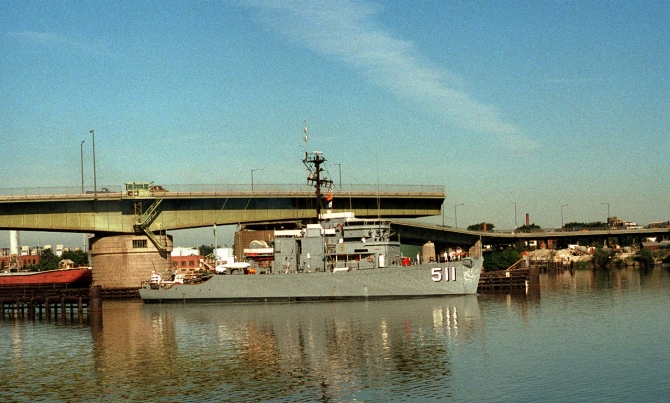
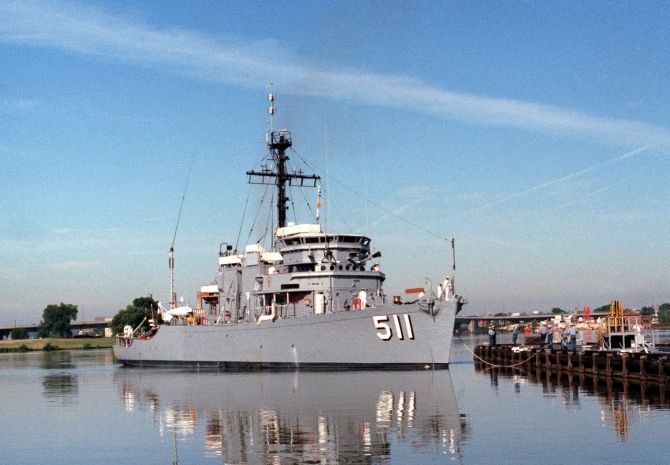
Affray continued to train reservists and accomplish upkeep throughout 1984 and 1985. From 15 to 19 January 1985, the ship laid exercise mines in the west passage of Narragansett Bay and carried out a Q-Route survey — a system of pre-planned shipping lanes in mined or potentially mined waters used to minimize the area the mine countermeasures commander must keep clear of mines. She shifted from Commander, Mine Group 2 to Commander, Naval Surface Group 4 on 1 March. Repeated contract problems for an interim drydocking availability delayed the work on the ship, resulting in “a single prolonged availability period” (8 March–8 May). Affray transferred her ammunition and pyrotechnics to Exploit on 29 May, and began the availability at Newport Offshore, Ltd., on 3 June 1985. Problems with material acquisition and growth work delayed the project, and Hurricane Gloria compounded the delays when it swept through the area. Affray got up steam and shifted berths to avoid the tempest on 26 September, remaining in a Hammerlock moor just north of the jetty at Coddington Cover near Middletown, R.I., for two days, and then riding out Gloria in the lee of Aquidneck Island without damage. Lt. Cmdr. Edward J. Kujat relieved Gallagher on 16 November.
After completing her yard work the ship onloaded ammunition at Naval Weapons Station Yorktown, Va., passing through the channel to the station in heavy fog (3–9 February 1986). Following a couple of months of training and upkeep at Charleston, the ship made for the warmer waters off Florida (6–28 April). While steaming en route on 9 April, her crewmen recovered a large waterproof bag which her historian diplomatically described as containing “several small bags of white powdery substance.” The minesweeper turned over the bag to federal agents upon arriving at Port Everglades (10–14 April). Affray moored back in Charleston (17–24 April) before returning to Newport. She spent much of the spring and summer training, including another sojourn to Virginian waters in June. The highlight of the summer consisted of a cruise to Halifax (23–30 July). While carrying out minehunting and Z-Bird vectoring on 12 September, a sonar casualty forced a change to a combination influence sweep, which proved unsatisfactory due to an engine problem with the T-6 Minesweep Generator, and the ship cancelled a mine readiness certification inspection.
Affray steamed to Charleston for a mine countermeasures mobile training team visit (4 February–5 March 1987), her historian noting that en route the ship streamed the “magtail.” During the training the vessel streamed her “Double 0” gear and performed “Z-Bird” vectoring, before returning to Newport. She steamed northerly courses for First Shield 87 (8–15 March), carrying out mine countermeasures exercises and visiting Portland, Maine (12–13 March). The exercise’s objective consisted of mine countermeasures operations prior to breaking in a resupply convoy bound for European waters.
The ship next (19 April–10 May) took part in Solid Shield 87 off Morehead City, N.C. On 23 April she conducted a Q-Route survey. On 29 April heavy seas and high winds caused Impervious to lose steerageway and she grounded while entering the Morehead City channel to embark an EOD team. Despite strenuous efforts by her crewmen to float the ship free, she remained on the sandbar for three days until Military Sealift Command-manned fleet ocean tug Mohawk (T-ATF-170) pulled her off. Affray meanwhile rendezvoused with amphibious assault ship Saipan (LHA-2), amphibious transport dock Trenton (LPD-14), and tank landing ship Harlan County (LST-1196), and on 4 May led them to the invasion beach. Following the minesweeper’s return to Newport, she took part in the Bicentennial of New Bedford, Mass. (12–15 June). The ship completed an overhaul at Braswell Shipyards, Inc., at Charleston (21 July–14 September). The crewmen berthed at a local Howard Johnson’s Motor Lodge during the extensive woodworking and engineering repairs. Affray discovered six of the nine exercise mines laid during Agile Knight 88 off New London, Conn., and led the submarines out of harbor during their sortie (19–22 October). During the winter of 1987–1988 the ship changed out the No. 1 main diesel engine.
She completed a 5,000 mile voyage to Corpus Christi, Texas, to participate in exercise Urgent Quest 88 (29 January–14 March 1988). Following a brief stop at Little Creek, Va., to disembark selective reservists, Affray continued her cruise with a visit to Mayport (3–5 February). The ship stopped at Key West, and on 9 February stood out of that port to continue rounding Florida. Affray rendezvoused with Exploit at Tampa, but Exploit developed engine trouble while the pair crossed the Gulf of Mexico, and they diverted to Panama City on 15 February. Affray stopped long enough to refuel and then resumed her voyage, reaching Corpus Christi on 18 February. The ship tested remote operated vehicles (ROVs) for their suitability for deployment to the Persian Gulf (20–24 February), and after a three-day layover at Corpus Christi, came about from Texas waters for her return journey. The warship visited Fort Lauderdale (3–6 March) and Charleston (7–8 March) before returning home. Lt. Cmdr. Peter S. Varsanyi relieved Cmdr. Kujat on 9 April.
Affray visited Greenport, N.Y. (12–15 May). “Cascading” engineering casualties prevented her from taking part in fleet exercise 2-88, and she came about and returned to port (31 May–3 June). The ship hosted Okanagan (S.74) when the Canadian submarine visited Newport (20–23 June), and led frigate Connole (FF-1056) out of port on 2 August. The following day she set sail for Halifax, but engineering casualties and heavy weather compelled the ship to come about for home barely one day out. Affray picked up dignitaries at Earle on 25 August, visited Perth Amboy, N.J. (26–28 August), and then offloaded her ammunition and the visitors at Earle before returning to Newport on 2 September. The ship next (28 September–1 October) took part in Homecoming Week at the Naval Academy at Annapolis, Md.
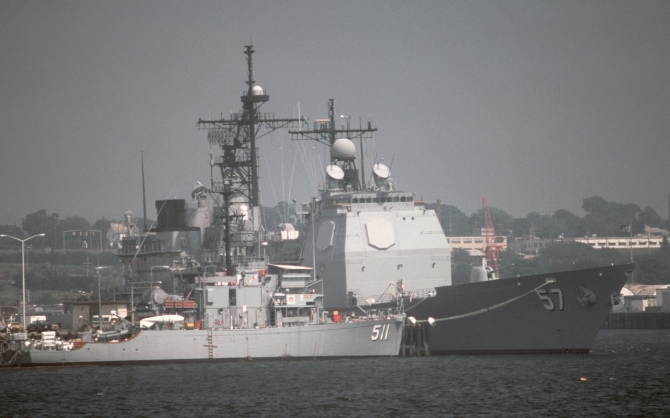
Affray changed out her main propulsion and minesweeping generator systems from Packard to Waukesha engines during a dry dock selected restricted availability at Braswell (2 October 1988–25 July 1989). Following the ship’s extensive yard work, she utilized mechanical sweep techniques, influence minesweeping, and minehunting techniques during a two week mine countermeasures mobile training team visit in August. The warship set sail from Newport for Charleston to conduct a routine test of her magnetic field, known to her crewmen as “stray fields” (24 August–8 September). A casualty to her minesweeping generator, however, prevented Affray from completing the stray fields, and she returned home to repair the generator, narrowly escaping Hurricane Hugo as the tempest devastated the South Carolina coast. The ship took part in First Shield 89, an Atlantic Fleet exercise involving USN and USCG helicopters and ships clearing exercise mines from the approaches to New York City (24–28 September).
Lt. Cmdr. G. Jeffrey Fullerton relieved Varsanyi on 2 June 1991. The minesweeper completed a docking selected restricted availability at Metal Trades, Inc., at Hollywood, S.C. (3 October 1991–January 1992). The ship next took part in Ocean Venture ’92 off the coast of North Carolina in May 1992. She visited Morehead City just prior to the exercise, and detected and “prosecuted” the majority of the exercise mines laid during the operation. Lt. Cmdr. Steven R. Strausser relieved Lt. Cmdr. Paul S. Holmes the following month. Affray visited Davisville, R.I., carried out maintenance at her home port, and then participated in the annual Lobster Festival at Winter Harbor, and an emergent port visit to Salem, Mass. (both in August).
As Affray’s decommissioning drew near she visited Charleston and Savannah (September), and inspectors declared her “fit for further service” in October. Affray was nonetheless decommissioned on 20 December 1992 and stricken on 28 June 1993. The Naval Inactive Ship Maintenance Facility at Portsmouth, Va., conducted her pre-disposal requirements, and then the Defense Reutilization and Marketing Service at Memphis, Tenn., oversaw her disposal.
Mark L. Evans
31 March 2016


